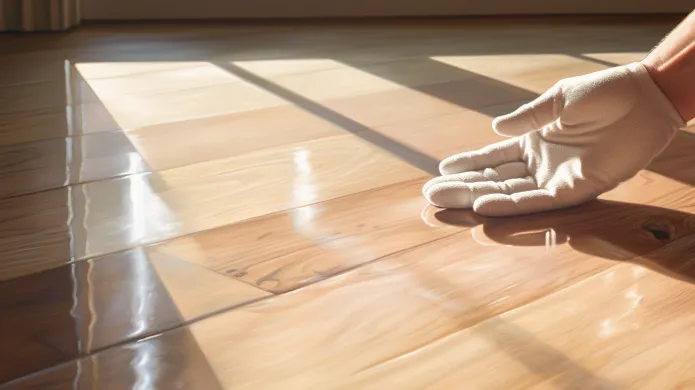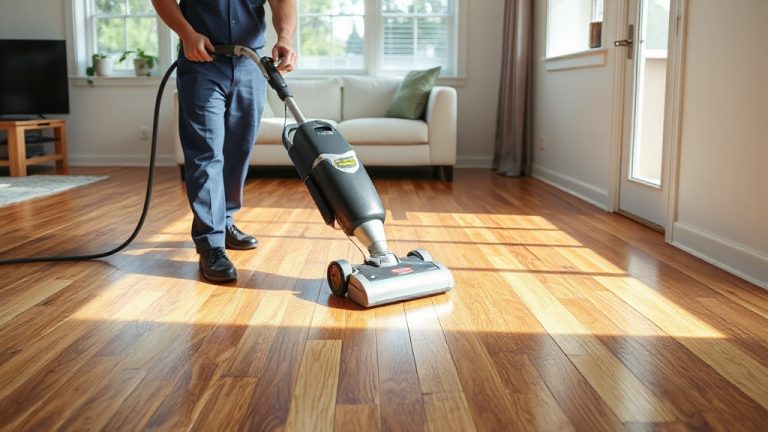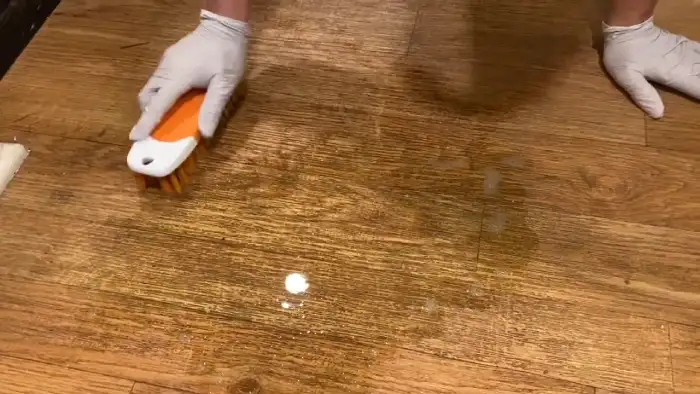How to Remove Grout Stains From Hardwood Floor: Steps to Follow
Hardwood floors are elegant and timeless, but maintaining them can be challenging. One of the most common problems that homeowners face is grout stains. Grout stains can be tricky to remove, especially if they have been sitting for some time.
But don’t worry, there are some easy steps to remove grout stains from your hardwood floors. You can start by blotting and cleaning the stained area as best as possible. If necessary, apply isopropyl alcohol, mineral spirits, or Goof Off to help lift the stain.
You can also try using R2X Stain and Soil Remover for an extra boost or a diluted vinegar wash as a last resort. If none of these methods work, consider alternative options such as sanding or refinishing.
Today, we will guide you through the step-by-step process of removing grout stains from your hardwood floor. Grout stains can be tough to remove, especially when sitting on your floor for a while.
How to Remove Grout Stains From Hardwood Floor: Step-by-Step Guide

If you’re dealing with grout stains on your hardwood floor, don’t worry, there are steps you can take to remove them.
- Step 1: Blot and Clean the Stained Area
- Step 2: Apply Isopropyl Alcohol, Mineral Spirits, or Goof Off
- Step 3: Use R2X Stain and Soil Remover (optional)
- Step 4: Try Diluted Vinegar Wash (if necessary)
- Step 5: Consider Alternative Methods (if necessary)
Step 1: Blot and Clean the Stained Area
First, grab a clean cloth or paper towel and blot the stained area on your hardwood floor to remove any excess grout residue. By removing any excess grout residue, you can better see the extent of the staining and determine the best course of action for cleaning it.
Next, prepare a solution of water and a pH-neutral cleaner according to the manufacturer’s instructions. Dampen a clean cloth or sponge with the solution and gently clean the stained area, working in small sections.
Rinse the cloth or sponge frequently and change the cleaning solution if it becomes dirty. This’ll help ensure that you’re effectively removing the grout stains from your hardwood floor without causing any damage to the wood.
Step 2: Apply Isopropyl Alcohol, Mineral Spirits, or Goof Off (if necessary)
To tackle stubborn grout stains on your hardwood floor, use isopropyl alcohol, odorless mineral spirits, or Goof Off. These cleaners can help break down the grout stain and lift it from the surface of the wood.
Simply apply a small amount of your chosen cleaner to the stained area and use a red Scotch Bright pad or medium bristle brush to scrub the stain away gently. Be careful not to scrub too hard, which can damage the wood. Once you have finished scrubbing, rinse the area thoroughly with water for a fresh, clean look.
When using isopropyl alcohol, mineral spirits, or Goof Off, follow the manufacturer’s instructions and use caution. These products can be harsh and may cause damage to the wood or other surfaces if not used properly.
Always test a small, inconspicuous area first to ensure the cleaner is safe for your hardwood floor. You can remove even the toughest grout stains from your hardwood floor and restore its natural beauty with patience and care.
Step 3: Use R2X Stain and Soil Remover (optional)
You can thoroughly clean your hardwood floor by trying out the optional R2X Stain and Soil Remover. It can help you achieve a spotless finish by tackling tough stains and soil on hardwood floors, making it a great addition to your cleaning routine.
Here are some tips on how to use it effectively:
- Apply the R2X Stain and Soil Remover directly to the stained area.
- Gently agitate the area with a soft-bristled brush or cloth.
- Rinse the area thoroughly with clean water.
Step 4: Try Diluted Vinegar Wash (if necessary)
If you’re still struggling with pesky marks on your beautiful wooden surface, it might be time to consider a diluted vinegar wash. This is a safe and effective way to remove grout stains from hardwood floors without causing any damage to the wood.
Mix equal parts water and white vinegar in a spray bottle. Then, dampen a white ‘Scrubby’ or soft cloth with the solution and gently scrub the stained area. Be careful not to saturate the wood with the vinegar mixture, which can damage water.
After scrubbing the area, rinse it thoroughly with clean water and dry it with a soft cloth. If the stain remains, repeat the process until it disappears. You can restore your hardwood floors to their original beauty with some patience and effort.
Step 5: Consider Alternative Methods (if necessary)
If the vinegar wash didn’t work and the grout stain remains, it’s time to consider alternative methods. However, be cautious with mechanical methods as they may damage the hardwood floor finish. Seeking professional assistance may be necessary to avoid causing more harm than good.
If you decide to handle it yourself, here are some alternative methods to consider:
- Chemical grout removers: These products contain potent chemicals that dissolve the grout residue. However, they can also damage the hardwood floor finish, so test on a small, inconspicuous area first.
- Sanding: Refining the finish and removing leftover grout residue may require sanding the floorboards. However, professionals should handle this method as it requires specialized equipment and expertise to prevent further damage.
- Heat gun: A heat gun can soften the grout residue, making it easier to scrape off. However, like chemical grout removers, this method can also damage the hardwood floor finish if not used properly.
- Pneumatic Air Hammer: Consider using a pneumatic Air Hammer with a wide flat chisel attachment for faster removal. However, approach this method with caution to prevent wood damage.
How do you remove tough grout stains from hardwood floors?

Removing tough grout stains from hardwood floors can feel like an impossible task, but fear not, there’s a solution. When the baking soda-vinegar paste doesn’t work, there are alternative methods to consider.
One option is to use a commercial grout cleaner specifically designed for hardwood floors. These cleaners are gentle and won’t damage the finish of your floors.
Another alternative is to use a steam cleaner. The heat from the steam will loosen the grime and stains, making them easier to remove. Follow the manufacturer’s instructions and avoid using too much water, as excess moisture can damage hardwood floors.
Does hydrogen peroxide remove grout stains from hardwood floors?
You’ll be happy to know that hydrogen peroxide is a natural and safe option for cleaning the grout on your beautiful hardwood floors.
Hydrogen peroxide is a mild acid that can break down and remove grout stains without damaging the wood. It’s also an effective disinfectant that can kill bacteria, viruses, and fungi hiding in your grout.
To use hydrogen peroxide on your grout stains, mix equal parts of hydrogen peroxide and water in a spray bottle and spray the solution onto the grout. Allow the solution to sit for 5-10 minutes to give it time to break down the stains.
Then, use a stiff-bristled brush to scrub the grout, working in a circular motion. Rinse the area with clean water and dry it with a towel. Repeat the process if necessary until the grout is clean and stain-free.
What should you not use to clean hardwood floor grout stains?
Now that we’ve established that hydrogen peroxide can effectively remove grout stains from your hardwood floor, it’s important to know what not to use when cleaning your floors.
It’s crucial to avoid straight ammonia, alkaline products, or abrasive cleaners, as they can scratch or dull the finish of your hardwood floors. Additionally, relying on lemon juice or a vinegar-and-water solution can damage your floors.
To ensure the longevity and beauty of your hardwood floors, it’s best to avoid using harsh chemicals or acidic solutions. Here are some items to steer clear of when cleaning your floors:
- Straight ammonia, alkaline products, or abrasive cleaners: These products can scratch or dull the finish of your hardwood floors, causing irreparable damage.
- Lemon juice or vinegar-and-water solutions: While these might seem like natural cleaning solutions, the acidity can harm your floors and cause discoloration over time.
Revitalized Your Hardwood Floors: Removed Those Pesky Grout Stains
You’ve successfully removed those pesky grout stains from your hardwood floor. Not only does your hardwood floor look brand new, but you also feel a sense of accomplishment. Remember, prevention is key. Make sure to wipe up any spills or stains from the floor immediately to avoid future headaches.
As the saying goes, “A clean home is a happy home.”By taking the time to clean and maintain your hardwood floors properly, you’re not only creating a beautiful living space but also ensuring the longevity of your investment.
So pay attention to your hardwood floors. Give them the love and care they deserve. Your home (and your feet) will thank you.







